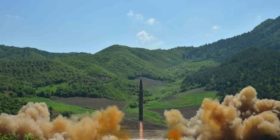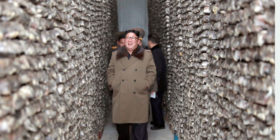In Pic :A photo released by North Korea’s Korean Central News Agency on March 11 shows North Korean leader Kim Jong Eun, center, on Wonae island, about six miles from the South Korean island of Baengnyong.
SEOUL—North Korea said on Tuesday it would restart its only nuclear reactor to provide plutonium for its weapons program, an announcement that added to already-heightened tensions on the Korean peninsula and drew swift international criticism.
U.N. Secretary-General Ban Ki-moon said he was “deeply troubled” by the rising tensions and said there was no need for Pyongyang to be “on a collision course with the international community.”
“Nuclear threats are not a game,” Mr. Ban said at a news conference in Andorra. “The current crisis has already gone too far.”
Experts cautioned that it could take years for the aging reactor to produce enough fissile material for more weapons. Some said the announcement could be a new tactic by Pyongyang to try to force aid and security guarantees from the U.S. and its allies after its recent escalation of warlike rhetoric.
The reactor at the Yongbyon plant, 90 kilometers, or 55 miles, north of Pyongyang, was closed in 2007, and the North Koreans destroyed the cooling tower the following summer as part of an aid-for-disarmament deal that soon collapsed.
The five-megawatt reactor was North Korea’s only source of plutonium for its weapons program. North Korea revealed a uranium-enrichment facility at the plant in 2010, another route to provide fissile material for nuclear weapons.
In a statement from its state news agency, North Korea said work to restart all facilities at Yongbyon will be “put into practice without delay.”
Experts said it would take many months for North Korea to get the reactor operational again and much longer to extract enough plutonium to make weapons.
“If everything went smoothly, North Korea would be able to get enough plutonium four years later to make two atomic bombs,” said Lee Ho-ryung, a specialist on North Korea’s nuclear program at the Korea Institute for Defense Analyses.
But the announcement comes as relations between the North and the South continue to spiral downward amid a near-daily exchange of threats and warnings between Pyongyang and Seoul. The U.S. said Monday that it was positioning two ships capable of shooting down ballistic missiles near the Korean peninsula in Washington’s latest show of force in support of Seoul.
Pyongyang’s announcement Tuesday was quickly criticized by its neighbors.
China Foreign Ministry spokesman Hong Lei said at a daily news briefing that China has “expressed our regret” over Pyongyang’s declaration. Mr. Hong said the situation on the Korean peninsula was “sensitive and complex” and called on relevant authorities “to keep talking and exercise restraint.” But he reiterated Beijing’s previous hesitant approach on international sanctions, saying they “cannot solve the problem fundamentally.”
South Korea’s Foreign Ministry spokesman called Pyongyang’s announcement “very regrettable.”
“We urge North Korea to live up to the promises it has made in the past and sustain denuclearization on the Korean peninsula,” Choi Tai-young said at a regular news conference.
Japan’s Chief Cabinet Speaker Yoshihide Suga told reporters that restarting the Yongbyon nuclear plant would represent a violation of promises made to its neighbors and the United Nations. “It would be a grave concern for Japan,” Mr. Suga said.
In Andorra, The U.N.’s Mr. Ban urged North Korea again “to fully abide by the relevant Security Council resolutions and refrain from making further provocative measures.”
Satellite imagery in recent months has shown construction work at the Yongbyon plant but it isn’t clear if North Korea has already started work to put its reactor back online.
Many outside analysts believe North Korea sees its nuclear threat as a negotiating tool to force the U.S. and other countries to provide it with money and security guarantees, and restarting its 1980s-era reactor would add further pressure to the North’s foes.
“I consider this a pretty serious move by Pyongyang in the series of steps it’s been taking to push the U.S. toward some form of negotiation,” said Narushige Michishita, an associate professor at the National Graduate Institute for Policy Studies in Tokyo.
North Korea has said repeatedly in recent days that its nuclear weapons program is now nonnegotiable and will be built up in order to provide security from what it sees as threats from the U.S. and South Korea. On Feb. 12, North Korea staged its third test of a nuclear weapon, a move that triggered an escalation in tensions on the peninsula and was followed by a series of provocative warlike threats from Pyongyang.
North Korea is thought to have enough plutonium-based fissile material for as many as a dozen small bombs. It isn’t clear if it has been able to develop a uranium-based bomb, but experts have speculated that it used uranium in its February test.
The uranium-enrichment facility at Yongbyon is North Korea’s only declared such facility, but experts suspect Pyongyang may have other enrichment centers.
North Korea has threatened to attack Washington with a nuclear weapon but it isn’t thought to be able to mount a nuclear weapon on a missile yet, or to be able to hit the mainland U.S. with a missile.
In its statement Tuesday, North Korea’s state news agency said the country would restart “all the nuclear facilities in Yongbyon including [the] uranium enrichment plant and 5 megawatt graphite moderated reactor which had been mothballed and disabled under an agreement reached at the six-party talks in October 2007.”
Although the reactor has been idled, Pyongyang has never publicly said it stopped enriching uranium at the site after revealing the enrichment facility there in 2010.
Since its first test of a nuclear bomb in 2006, North Korea has repeatedly asked the U.S. and other major countries to recognize it as a nuclear-weapons state and negotiate with it as an equal power.
“North Korea wants to show its willingness to become a nuclear power not only verbally but also in action. North Korea also wants to put huge pressure on the U.S. and the international community,” said Kim Yong-hyun, a North Korea expert at Dongguk University in Seoul.
North Korea started developing nuclear weapons in the 1970s, but its work proceeded slowly because of its poverty and international constraints and sanctions. From 1994 to 2002, North Korea formally halted the effort under an agreement with the U.S.
But the agreement fell apart after Washington in 2002 determined Pyongyang had started research on a second means of building nuclear weapons, using enriched uranium rather than the reprocessed plutonium that was explicitly covered in the 1994 pact.
In November 2010, North Korea showed U.S. scientist Siegfried Hecker that it was making progress in developing the skill to use uranium as a fuel for nuclear weapons. Officials gave Mr. Hecker a tour of a laboratory that housed thousands of centrifuges used to enrich uranium to a purity level required for use as weapons fuel.
North Korea also said on Tuesday the Yongbyon reactor would provide electricity for the energy starved country. The nation has frequent power outages because of its weak energy infrastructure. A supply of electricity from the Yongbyon plant would help alleviate some of those shortages.






Leave a reply